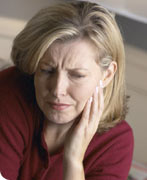There are numbers of condition that can cause pain which seem to be associated with a tooth. These conditions are associated with muscle injury and are non tooth-origin, although the pain may seem to be coming from a tooth or gum. One of the most common conditions is chronic myofascial pain.
Myofascial pain is a painful condition affecting the muscles and the sheath of the tissue — called the fascia (connective tissue that covers the muscles). This is caused by shortening of muscles fibers. It may involve either a single muscle or a muscle group. The pain is more localized or regional muscle pain compared to fibromyalgia, which is more widespread of muscle pain.
Myofascial pain usually involves muscle pain with specific “trigger” or “tender” points. Trigger points are tender points that cause pain that can be felt in another area of the body (referred pain). However, you will have difficulty to point the exact area of pain.
When you are in stress condition, the muscles often tighten, aggravating any areas of myofascial pain. In addition, it is known that stress decreases the body’s ability to control the pain.
Medical history
In addition to the local or regional pain associated with myofascial pain syndrome, there is possible history of depression and anxiety
Dental History
- May have attended many dentists, doctors and others in failed attempts to cure the pain
- Experience serial extraction to eliminate the pain
- Usually occur in adult
- Females are commonly affected (70%) compared to male
Symptoms
- Limited range of motion
- Characteristic of pain:
- Vague, constant, dull ache, Present all day everyday, poorly localized
- Usually involve upper part of face
- Start at one side of face first but often spreads to the midline
- Continuous nature of pain, often for years
- Sleep is not affected
3.There is presence of tender points that are tender to the touch and create a twitch response leading to pain
4.No specific causes are identified
5.Pain is occasionally bizarre, such as ‘like ants crawling over the face
6.The pain can be made worse with activity or stress
Treatment
It is best treated by stretching the painful muscles and employing stress management techniques. Physician or dentist will prescribe some medication to be taken to reduce the pain and stress such as antidepressant, anxiolytics, and anticonvulsant. However, certain medication such as Carbamazepine (anticonvulsant) has their own adverse effect (dizziness, drowsiness, ataxia, dry mouth, gastrointestinal distress) and need to be monitored by the physician.
.



![Reblog this post [with Zemanta]](http://img.zemanta.com/reblog_e.png?x-id=730a36ee-b904-4bd4-aa24-48fe5472ad2a)